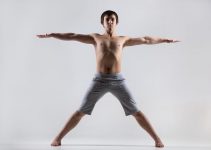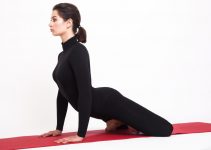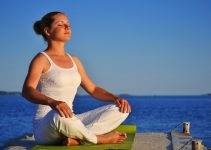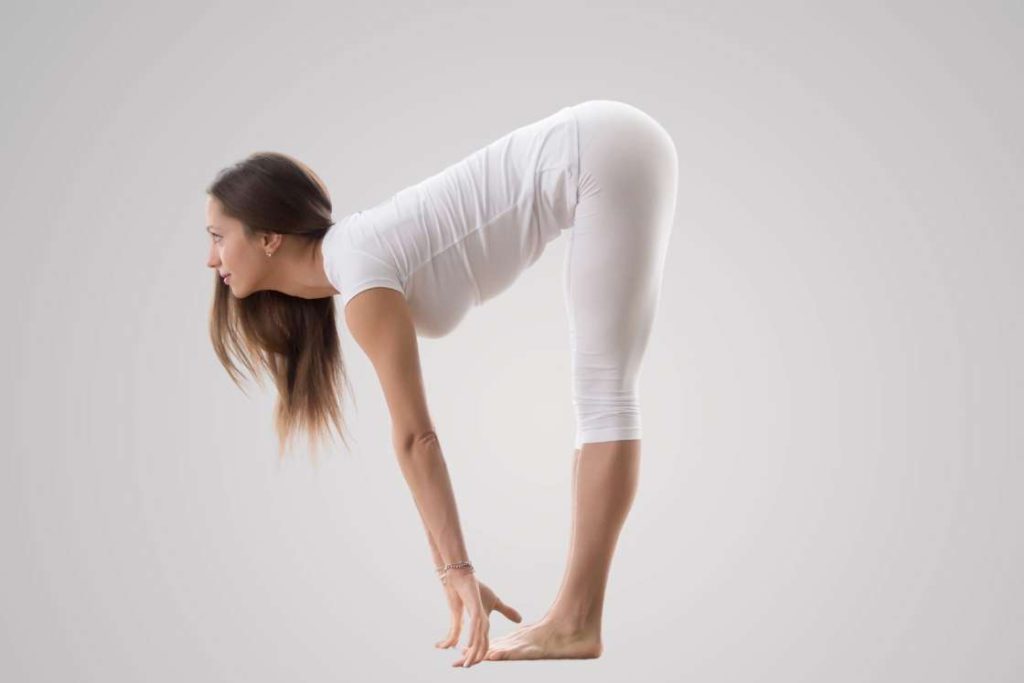
| Sanskrit Pronunciation | Ardha Uttanasana (ARR-dah OOT-tahn-NAHS-uh-nuh) |
| Meaning | Ardha = side / uttana = intense stretch / asana = pose |
| Pose Type | Standing and forward bend |
| Pose Level | Intermediate |
| Anatomy | lower back, hamstring, and upper body |
| Other Names | Standing half forward fold, halfway lift pose, intense half stretch pose |
Ardha Uttanasana is an intermediate pose that comes in between many ashtanga vinyasa flows. The most popular sequence for example is the Sun Salutation A and B series where it is helpful in the stretching of the lower back, hamstring, and upper body as well. Apart from this, it comes before Uttanasana (full standing forward fold) and leaning into the chaturanga dandasana.
The diving upper body into the lower makes it easy to configure the natural state of flexibility. Therefore, considering Ardha Uttanasana in your day to day yoga practice lowers the effort and raises the efficiency of physical movements.
Meaning
Ardha Uttanasana is a Sanskrit term where, ‘Ardha’ means ‘half’, ‘Uttana’ means ‘intense stretch’, and ‘asana’ means ‘posture’. In this pose, the upper body is bent forward to the extent where it remains almost parallel to the floor. This is the half position between bending completely down and standing tall. Therefore, this pose makes it easier for the practitioner to achieve the deep stretch that enhances the range of body movements.
Body movements required a particular angle around which we manage our day to day physical activities. Deep stretch in this pose not only eases up the movements but also assists the surrounding muscles to coordinate accordingly.
Hence, Ardha Uttanasana grants a flexible approach to realign your body in a better way, than before.
Ardha Uttanasana Practice Guide
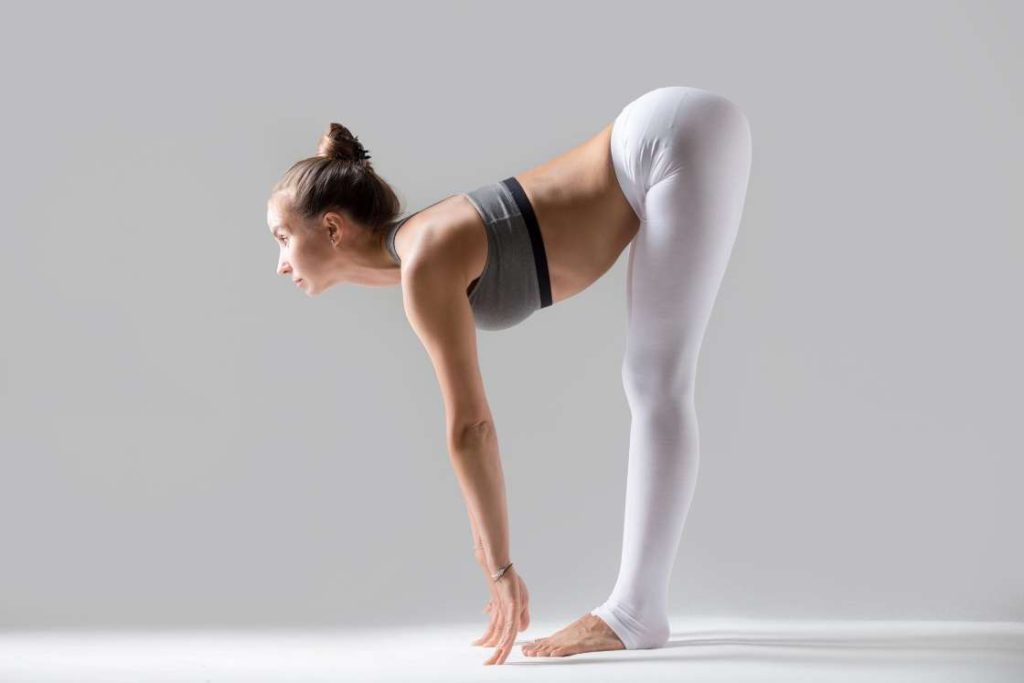
Contraindications
- Practicing Ardha Uttanasana should be avoided during later stages of pregnancy and menstruation.
- Practitioners with lower back and neck conditions refrain from this asana as it might disturb the present condition.
- It should be avoided in acidity. Lowering the body with suppression of the stomach could be harmful.
- Patients with Abdominal surgery in the past few months should avoid practice Ardha Uttanasana until or unless the doctor advises.
Preparatory Pose
- Balasana (Child Pose)
- Dandasana (Staff Pose)
- Ardha Bhekasana (Half Frog Pose)
- Adho Mukha Svanasana (Downward Facing Dog Pose)
How To Do Ardha Uttanasana (Steps)
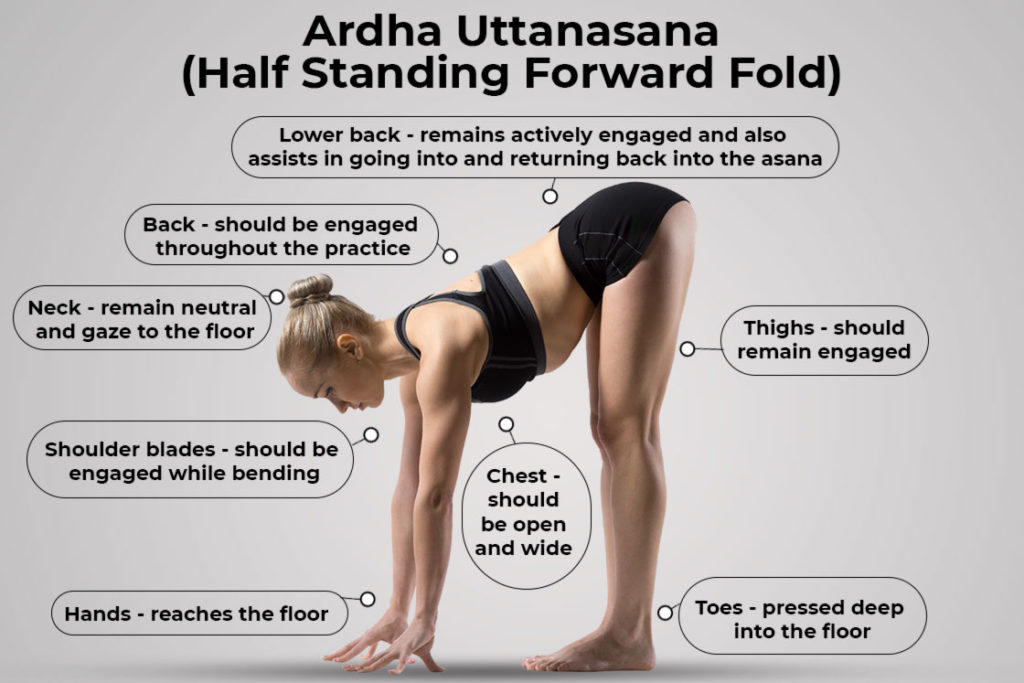
- Begin this asana by coming into a standing tadasana position. Your feet should remain hip-width distance, aligned to each other.
- Stretch your arms overhead in Urdhva hastasana and gaze upon your thumb tip.
- Now, exhale and bend from the lower back in the forward direction. Come into a tabletop position, back is slightly lower than hips level and palms touching flat on the ground. If necessary, micro bend your knees and reach down with your palms resting flat on the floor.
- From here, slowly lift your torso up to the point where it comes almost parallel to the floor. For this, you can raise your palms up and only your fingertips touching the floor.
- Your hand should be shoulder-distance apart, shoulder parallel to each other and the neck should be straight. Eyes looking to the floor.
- This is complete Ardha uttanasana.
- Maintain the position as long as it is comfortable by keeping breathing normally without any restriction. When you want to come out, inhale and come back from the lower back to a standing position to relax the body.
Beginners Tips
- It would be difficult for the beginners to touch the ground in one go due to stiffened hamstrings. So, they should bend their knees to reach the ground easily.
- Placing your hand on your thighs and knees might disfigure your pose. Avoid this as it makes a curve in the back as well, which does not open up the chest region while in the pose.
- There should be a balance between the lower back and the entire spine while bending forward. Make sure the spine remains straight and engaged during dropping the upper body forward.
- If beginners having difficulty in standing while doing the Ardha Uttanasana then one can spread the legs hip-distance apart.
Precautions
Ardha Uttanasana is helpful in maintaining the flexibility in the body only if performed rightly. Improper practice might block the opportunity of getting fruitful results in the long run.
- In case of a hamstring injury, avoid going fully into the asana or one can simply bend the knees to reduce the stress over the hamstrings.
- Practitioners with sciatica condition should bend their knees along with inward positioning of toes.
- One should not exaggerate the neck in an upward and downward direction. Leaving it to the neutral adds om to the fineness of the posture.
- Avoid bending into the Ardha Uttanasana through the spine as it might cause you to lose balance. Prefer Lower back in going and coming back into the posture.
Props and Modifications
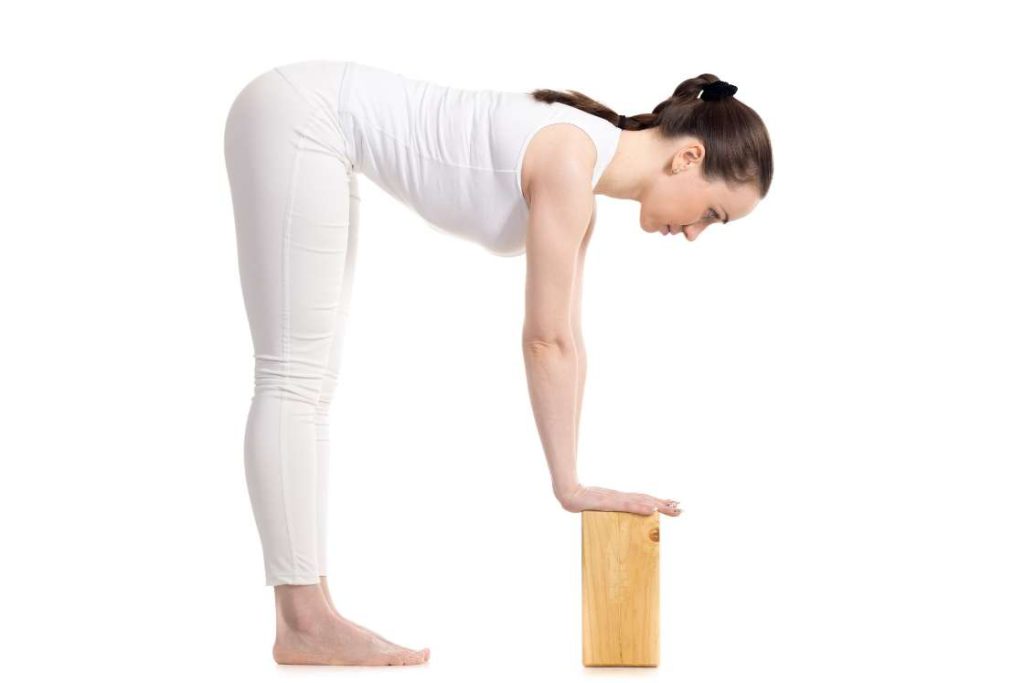
In case you need assistance of props in ardha uttanasana to bend forward perfectly, follow the below strategies;
- Ardha Uttanasana is not for the final stage of pregnancy but initial stages one can go by spreading their legs wide enough to avoid thigh and stomach contact. One can go for the wall or for the seat of the chair, to get the support from!
- One can use yoga blocks in the condition of the herniated disk as it would be painful to forcefully reach the ground while dropping down.
- Due to weak thighs, it is normal that your feet lose the right alignment of the posture. To make it right, place a yoga block between the thighs and squeeze it nicely to find stability in the posture.
- Practitioners with weak backs might find it hard to balance the Ardha Uttanasana. So, taking wall or chair support can be helpful here.
Follow up Poses
Variations
By changing some place of feet one can practice the variations poses of Ardha Uttanasana;
1. Half bound lotus standing forward bend
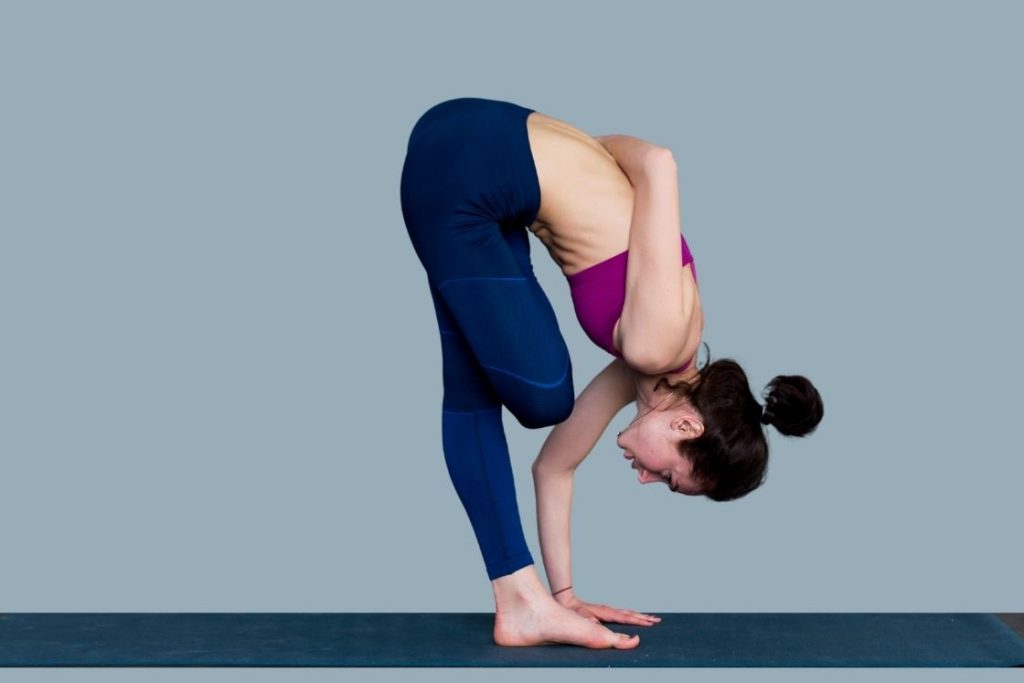
Also known as Ardha baddha padmottanasana, is an advanced variation of Ardha uttanasana where bending forward is followed by one leg in the lotus pose position. In this variation, the back forms a convex curve that eases up the reach of hands to the toes.
- First of all, come into a standing pose and hands lie on either side of your body.
- Now, exhale and bend forward to grip the big toes with help of the index finger, middle finger, and thumb.
- From here, Inhale to lift the chest and straight up the arms.
- Again exhale to bend elbows and to stabilize the big toe into the ground.
- After taking the shoulder away allow the head to hang downwards.
- Remain in this position for some time and then come back to relax.
2. Half Forward Fold Hands On Back
This is a comparably easy variation to Ardha Uttanasana where hands need to be placed above the hip. It gives more chest opening as by lifting hands up more chest gets more space to open.
- Firstly, stand straight and then exhale to bend forward. Makes sure to engage your lower back while coming down.
- Drop your hand down let them reach the floor. Press your toes into the ground.
- Now, inhale and swing your hand behind right above the hip. Your palm facing upward. Gaze down to the floor. Press your toes deep into the ground to find balance here
- After few breaths, exhale to return into the bending position and hen inhale to come back in the final pose or Namaste mudra.
Ardha Uttanasana Benefits
1. Strengthens core muscles
Holding of the torso in Ardha Uttanasana requires the active support of core muscles, which puts immense tension on the concerning region that further solidifies the muscles in the long run.
2. Makes Hamstrings flexible
Reaching to the ground through the hand gives a deep stretch to the hamstrings muscles. However, regular practice strengthens the hamstring along with flexibility.
3. Strengthens the Entire Lower back
In Ardha Uttanasana, going into the posture and returning from the posture is done by engaging the lower back. It provides the necessary support to the spine and torso. In doing so, the muscles and bones of this region face good blood flow that further nourishes the muscular ass well as the skeletal region of the area.
4. Lower Hypertension
Practicing Ardha Uttanasana is one of the effective yoga poses to lower the effect of hypertension. It works in a dynamic way to tackle hypertension. However, it also manages the inducing factors like diabetes, stress, etc that further adds on to lowering in the Hypertension [efn_note] Yoga for hypertension: A systematic review of randomized clinical trials https://www.sciencedirect.com/science/article/abs/pii/S0965229914000405 [/efn_note] issues.
5. Strengthens Respiratory system
This asana improves the blood circulation throughout the body, which makes the lungs work as per the needs. This develops and strengthens them in the long run. However, Ardha Uttanasana also helps in chronic respiratory disease [efn_note] An assessment of the effects of Iyengar yoga practice on the health-related quality of life of patients with
chronic respiratory diseases: A pilot study https://downloads.hindawi.com/journals/crj/2013/265406.pdf [/efn_note] on practicing daily.
6. Stimulates chakras
Ardha Uttanasana is one of the asana that stimulates more than one chakra. Heartoe Anahata chakra, Root or Mooldhara chakra, Naval or Solar plexus chakra are some of the chakras, which can be activated if practiced with right breathing techniques. Hence, have combined effect.
Conclusion
Ardha Uttanasana is a sister pose for the primary yoga pose named Uttanasana. It is an effective yogic practice that not only increases the range of body movements but also strengthens them if practiced regularly.
However, apart from providing physical benefits Ardha Uttanasana proved to be beneficial in promoting the mental health of the practitioner. Practice under the expert or skilled yoga teacher leads to the stimulation of the various chakras of the body.
